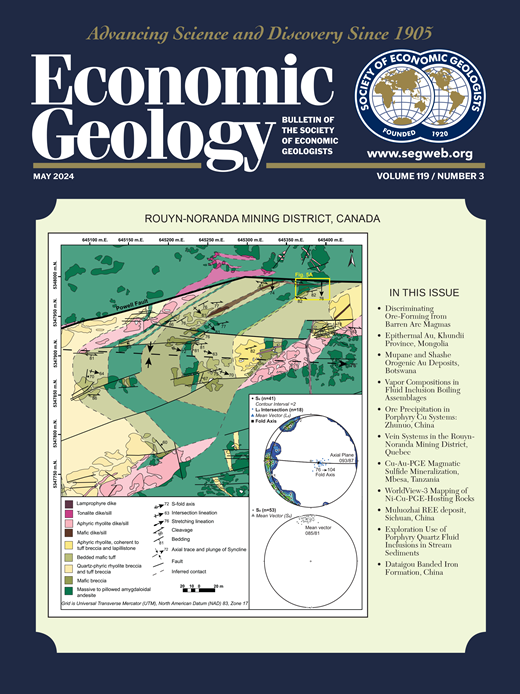Syn- and Postdepositional Controls on the Composition of Pyrite and Pyrrhotite in the Windy Craggy Cu-Co Volcanogenic Massive Sulfide Deposit, British Columbia, Canada
IF 4.9
1区 地球科学
Q1 GEOCHEMISTRY & GEOPHYSICS
引用次数: 0
Abstract
Pyrite and pyrrhotite from the Windy Craggy volcanogenic massive sulfide (VMS) deposit, British Columbia, Canada, were investigated using combined in situ compositional mapping (by laser ablation-inductively coupled plasma-mass spectrometry [LA-ICP-MS]) and microstructural mapping (by electron backscatter diffraction [EBSD]) to elucidate how their compositions were affected by hydrothermal processes and subsequent deformation and metamorphism. Early pyrite was precipitated rapidly from cool (<250°C) hydrothermal fluids with a significant seawater component and incorporated substantial quantities of a wide variety of trace elements, including the low-temperature suite As-Ag-Sb-Au-Tl-Pb. As the hydrothermal system evolved, this early pyrite was overgrown during subseafloor zone refining and replaced by massive pyrrhotite-chalcopyrite-pyrite mineralization containing Co-Ni-Cu-Se-Mo-Bi, under high-temperature (~350°–380°C), reducing conditions. During deformation and metamorphism at greenschist facies conditions (≥370°C), pyrrhotite was mechanically remobilized by dislocation creep and dynamic recrystallization, expelling elements hosted in mineral inclusions (Cu, Mo, Ag, Sb, Pb, and Bi) but largely retaining direct, stoichiometric substitution elements (Co, Ni, and Se). Pyrite is more competent than pyrrhotite, but local dynamic recrystallization did occur and similarly expelled most elements incorporated by coupled substitution or in inclusions (Cu, Zn, Mo, Ag, Sn, Sb, some Te, Au, Tl, Pb, and Bi), while retaining direct substitution elements (Co, As, Se, and some Te). Synmetamorphic phases, like pyrite overgrowths and minor cobaltite, are distinctly Co and As rich. Within the Windy Craggy deposit, significant variations exist in pyrite and pyrrhotite trace element compositions, reflecting both syn- and postdepositional processes. In general, low-temperature elements are present in sulfide mineral inclusions or as coupled substitutions and may be positive indicators of proximity to hydrothermal mineralization, but they are readily remobilized during hydrothermal, metamorphic, or deformational sulfide modifications. Several high-temperature elements are incorporated tightly into the crystal lattice of pyrite and pyrrhotite and are thus better retained through such modifications.加拿大不列颠哥伦比亚省Windy褶皱Cu-Co火山块状硫化物矿床中黄铁矿和磁黄铁矿组成的沉积前后控制
对加拿大不列颠哥伦比亚省Windy Craggy火山块状硫化物(VMS)矿床中的黄铁矿和磁黄铁矿进行了原位成分作图(激光烧蚀-电感耦合等离子体质谱[LA-ICP-MS])和显微结构作图(电子背散射衍射[EBSD]),以阐明其成分如何受到热液过程及其随后的变形和变质作用的影响。早期黄铁矿是从含有大量海水成分的低温热液(<250°C)中快速析出的,并含有大量各种微量元素,包括低温组As-Ag-Sb-Au-Tl-Pb。在高温(~350°~ 380°C)还原条件下,早期黄铁矿在海底精炼过程中过度生长,被含Co-Ni-Cu-Se-Mo-Bi的块状磁黄铁矿-黄铜矿成矿所取代。在绿片岩相条件下(≥370°C)的变形和变质过程中,磁黄铁矿通过位错蠕变和动态再结晶进行机械再活化,排出矿物包裹体中的元素(Cu、Mo、Ag、Sb、Pb和Bi),但大部分保留了直接的化学取代元素(Co、Ni和Se)。黄铁矿比磁黄铁矿更强,但也发生了局部动态再结晶,并同样排出了通过偶联取代或包裹体中的大部分元素(Cu、Zn、Mo、Ag、Sn、Sb,部分Te、Au、Tl、Pb和Bi),同时保留了直接取代元素(Co、As、Se和部分Te)。同变质相,如黄铁矿过度生长和少量钴矿,明显富含Co和As。在Windy Craggy矿床中,黄铁矿和磁黄铁矿的微量元素组成变化明显,反映了沉积前后的过程。一般来说,低温元素存在于硫化物矿物包裹体中或以偶联取代形式存在,可能是热液矿化的积极标志,但它们在热液、变质或变形硫化物修饰过程中很容易再活化。几种高温元素被紧密地结合到黄铁矿和磁黄铁矿的晶格中,从而通过这种改性得到更好的保留。
本文章由计算机程序翻译,如有差异,请以英文原文为准。
求助全文
约1分钟内获得全文
求助全文
来源期刊

Economic Geology
地学-地球化学与地球物理
CiteScore
10.00
自引率
6.90%
发文量
120
审稿时长
6 months
期刊介绍:
The journal, now published semi-quarterly, was first published in 1905 by the Economic Geology Publishing Company (PUBCO), a not-for-profit company established for the purpose of publishing a periodical devoted to economic geology. On the founding of SEG in 1920, a cooperative arrangement between PUBCO and SEG made the journal the official organ of the Society, and PUBCO agreed to carry the Society''s name on the front cover under the heading "Bulletin of the Society of Economic Geologists". PUBCO and SEG continued to operate as cooperating but separate entities until 2001, when the Board of Directors of PUBCO and the Council of SEG, by unanimous consent, approved a formal agreement of merger. The former activities of the PUBCO Board of Directors are now carried out by a Publications Board, a new self-governing unit within SEG.
 求助内容:
求助内容: 应助结果提醒方式:
应助结果提醒方式:


